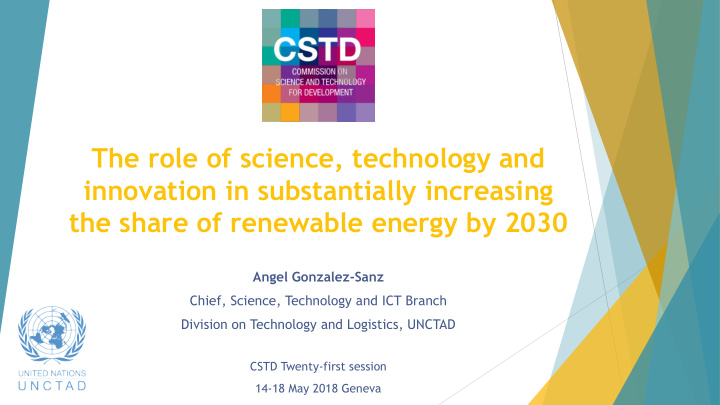



The role of science, technology and innovation in substantially increasing the share of renewable energy by 2030 Angel Gonzalez-Sanz Chief, Science, Technology and ICT Branch Division on Technology and Logistics, UNCTAD CSTD Twenty-first session 14-18 May 2018 Geneva
Context Synergies between Goal 7 and other SDGs 1.1 BILLION people 2.8 BILLION people without access to without access to clean electricity energy
Global trends in renewable energy deployment Figure 1. Global primary energy demand by Figure 2. Global electricity generation energy source 1990 vs 2014 4500 4000 Primary energy demand (mtoe) 3500 23% Renewables 14% of global energy 3000 16% Hydropower mix 2500 5% Wind, geothermal, solar , and tidal power 2000 combined 1500 2% Biomass and waste 1000 500 Non- renewables 0 Coal Oil Gas Nuclear Renewables 1990 2014 Source of data: IEA
Drivers, inhibitors and emerging technologies Cost and Finance affordability Drivers and inhibitors of Technical renewables maturity development and Integration deployment into electricity systems Environmental Appropriate sustainability skills Emerging technologies Vehicle-to-grid Digitalization of Third generation integration energy systems solar photovoltaics
Renewable energy market and policy design Technological innovation can be accelerated both by international competition and cooperation Policy learning: from feed-in tariffs to auctions Governments play crucial role in renewable energy innovation and deployment: Market demand for renewables Mix of supporting policies such as: funding research and development, creating demand through deployment incentives, reforming energy markets and setting standards, strengthen investor confidence Integrating renewables to electricity grids Need for innovation in enabling technologies that can help to integrate variable renewables into electricity systems: Storage Smarter electricity systems – integration of digital technologies Technologies to increase demand-side flexibility Need for infrastructure development
Extending access to electricity Access to electricity can improve livelihoods through different channels Technological progress and cost reductions in renewables represent an opportunity for electrification in rural areas: Off-grid, mini-grid and grid-based solutions Affordability is key: micro-finance, pay-as-you-go models Incentives for private sector Renewable energy for household purposes Using traditional biomass for cooking has serious health, environmental and social consequences Solutions: More efficient and sustainable use of biomass Modern cooking fuel and technologies Challenges: affordability and cultural resistance Engagement of women is crucial
1. Countries have different national renewable energy pathways Key policy 2. Policy mixes are necessary to support renewable energy deployment considerations 3. International and regional cooperation have a key role to play
Examples of international cooperation in renewable energy Mission Innovation South African Solar Thermal and Demonstration Initiative (SOLTRAIN) Global initiative of 22 countries Financial contributions and the EU Accelerates global clean energy Installed solar heating systems and trained locals innovation for universal accessibility Photo: SOLTRAIN Global Alliance for Clean Cookstoves Solar panel factory in Mozambique Public-private partnership Joint investment of Supports research, design and Governments implementation of programs for Technology and skills transfer improved cookstoves Photo: Global Alliance for Clean Cookstoves
Key policy suggestions Increase national support for research and development activities Member States Adopt policy mixes that allow for flexibility and improve policy coordination Recognize and consider the social and cultural contexts of local communities Promote North-South, South-South and triangular partnerships Build domestic innovative capabilities and engage with local communities International community Facilitate international and regional joint research activities Encourage international science, technology and innovation collaboration Improve the interconnection of grid infrastructures across borders Support multi-stakeholder collaboration CSTD Improve coordination among stakeholders and enable partnerships Encourage the sharing of lessons between countries and regions Identify mechanisms for improving capabilities in developing countries
Thank you for your attention http://unctad.org/cstd stdev@unctad.org
Recommend
More recommend